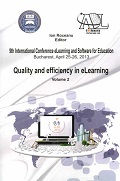SIMULATION OF COMBINATIONAL CIRCUITS USING MULTISIM: TRANSFORMATION OF TRADITIONAL SCHOOL INTO A MODERN
SIMULATION OF COMBINATIONAL CIRCUITS USING MULTISIM: TRANSFORMATION OF TRADITIONAL SCHOOL INTO A MODERN
Author(s): Ştefan KOPRDA, Martin MagdinSubject(s): Education
Published by: Carol I National Defence University Publishing House
Keywords: Multisim; Simulation; E-learning; Student skills
Summary/Abstract: The main aim of education reform in the European Union is the transformation of traditional school into a modern. The task of reform is purposeful and systematic development of skills and competencies especially in the context of a focus on science (Project ROSE - Relevance of Science Education). From the wide range of similar projects such as is project ROSE is a resulting fact that guys are more interested in the technique and everything associated with it, while girls are more focused on issues of a humanitarian nature. In this paper we provided an example of the use of advanced IT to support the teaching of subject Computer Architecture. The traditional form of teaching this course is focused on the memorization of electrical schemes, which represent the functional units of a computer, possibly explaining the operation of its individual components. When transform traditional form to modern teaching methods, we focused on the use of simulation program Multisim that allows to the students a relatively simply gradually develop their critical thinking. In this paper we present a series of examples that we have implemented with students. Examples was focused on non-linear transistor level, combination (AND, NAND, OR, NOR, NOT) and sequential logic circuits (RS), which form the basic architecture of computers. All examples were solved repeatedly with students in the academic years 2009 - 2012. To evaluate the effectiveness of teaching using program Multisim we used a questionnaire in which learners express their views on the quality and method of teaching.
Journal: Conference proceedings of »eLearning and Software for Education« (eLSE)
- Issue Year: 9/2013
- Issue No: 02
- Page Range: 651-655
- Page Count: 5
- Language: English

